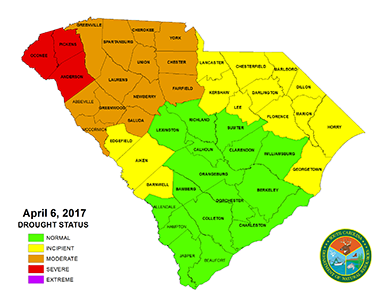DNR News** Archived Article - please check for current information. **
Drought committee makes few changes to S.C. drought statusesApril 6, 2017
The South Carolina Drought Response Committee met via conference call Thursday to analyze the drought statuses of counties statewide. While the state has seen rainfall during the last six weeks, some areas continue to battle a level of drought and are trying to recover from long-term lack of precipitation.
All of the Northeast counties are now classified as incipient- that’s an upgrade for all counties with the exception of Lancaster and Kershaw, which were already at incipient status. The Central counties stayed the same with the exception of Georgetown County, which was upgraded to incipient status. And all counties in the West and South regions maintained their current statuses (see larger map).
"Rains over the last two weeks have accelerated field preparation and corn planting," S.C. Department of Agriculture Assistant Commissioner Aaron Wood stated. "Winter wheat, cool-season pasture, spring forage, and early-season vegetable yields look to be down because of poor growing conditions."
Reports show soil moisture across the state is below the five-year average, and this information raises cause for concern as South Carolina approaches the growing season and warmer weather.
"You have to understand that we have been very dry for a very long time, and wet for a short period of time," Naturalist and West Area Drought Committee Member Dennis Chastain said. "There has been some conspicuous improvement in the upper levels of the soil and the near term looks good for the beginning of the planting season, but at the deeper levels the soil is still very dry. And these upper Savannah reservoirs look like what you would see during a long hot, dry summer."
"Wildfire activity normally peaks in April, so we do expect to have an uptick in fires through the rest of the month," SCFC Forest Protection Chief Darryl Jones pointed out, "until 'greenup' occurs, when the grasses and other plants on the forest floor begin growing."
Lugoff-Elgin Water Authority General Manager Mike Hancock added that some regions are interdependent due to the waterways flowing through neighboring counties and states, and those circumstances have to be taken into consideration when the committee discusses the possibility of changing drought statuses.
"The Catawba-Wateree Basin is in Low Inflow Protocol Stage 1 Drought according to Duke Energy's Drought Management Plan, which provided additional support for maintaining incipient at least along the waterway" he stated.
The Upstate counties will remain in their current drought statuses due to low streamflow levels and notable declines in water levels for reservoirs in the Savannah and Saluda Basins. The recent rains improved streamflow conditions, but those improved conditions are expected to only be temporary.
“The Pee Dee region has experienced below-normal streamflow conditions over the past several months and supported an upgrade for the counties in this region to be changed to incipient drought,” SCDNR Hydrologist Scott Harder said.
"Even though we have had significant rainfall in the last few days, the Drought Response Committee members representing the ten-county Northeast drought management area agreed to place these counties in the incipient drought status, Clemson Extension Agronomy Agent Patricia DeHond added. "Until recently, we were behind in soil moisture. And current drought indices, streamflow and lake levels all indicate drought conditions are moderate to incipient, with little to no additional rainfall in the forecast for the next two weeks."
The committee will meet again before the end of May to discuss drought conditions and change county drought statuses if necessary.
| Area | Personnel | Number |
|---|---|---|
| Coastal, Midlands | David Lucas | 843-610-0096 |
| Marine | Erin Weeks | 843-953-9845 |
| Upstate, Midlands | Greg Lucas | 864-380-5201 |
After Hours Radio Room - 803-955-4000

